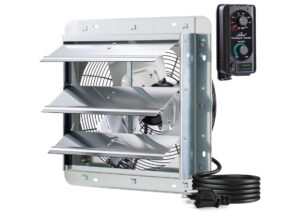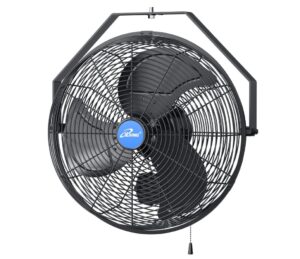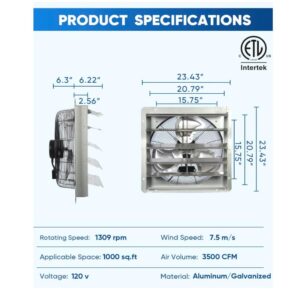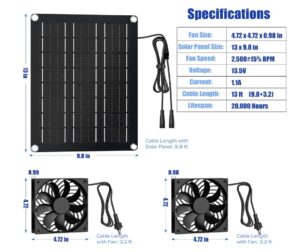Solar Fan vs Electric Fan for Greenhouses: Which One Should You Buy?
If you’ve spent any time in a greenhouse, you know how quickly the heat and humidity can build up even on a mild day.
Without proper ventilation, that controlled growing environment can turn into a plant-killing oven in just a few hours.
That’s where greenhouse fans come in. These simple tools play a huge role in maintaining airflow, regulating temperature, and preventing stagnant air.
But not all fans are the same and if you’re shopping for one, you’ll quickly run into a common question:
Should you go with a solar powered fan or an electric one?
Both have their strengths. Solar fans are great for energy savings and remote setups, while electric fans offer powerful, reliable airflow.
In this guide, we’ll break down the key differences, compare pros and cons, and help you choose the best option based on your greenhouse size, budget, and environment.
Table of Contents
ToggleWhy Greenhouse Ventilation Matters
Greenhouses are designed to trap sunlight and warmth that’s how they help plants grow faster. But that same design can backfire if the air inside gets too hot or too moist.
Without proper ventilation, here’s what can go wrong:
1. Heat Buildup
Even in spring or fall, greenhouse temperatures can rise 20–30°F higher than outside. That might seem good at first — but too much heat can stress plants, slow down growth, or even kill delicate seedlings. A fan helps move the hot air out and pull cooler air in.
2. Humidity Problems
Plants give off moisture through transpiration. If that moisture just hangs in the air, humidity levels can spike — leading to mildew, mold, and a higher risk of fungal infections. Ventilation helps dry the air and keep humidity in check.
3. Stagnant Air = Weak Plants
Still air isn’t just uncomfortable — it’s unhealthy for your plants. Stagnant air leads to poor CO₂ circulation, which plants need for photosynthesis. Plus, it invites pests and diseases to settle in. Fans create gentle airflow that strengthens stems and improves overall plant health.
In short, ventilation is not optional in a greenhouse it’s just as important as sunlight and water. And choosing the right fan system is a big part of that.
What Is a Solar Greenhouse Fan?
A solar greenhouse fan is exactly what it sounds like a fan that’s powered entirely by the sun. Instead of plugging it into the wall, you connect it to a solar panel (usually included in the kit).
When the sun shines, the fan spins. No wires, no power bills, and no complicated setup.
These fans are often compact, lightweight, and portable, making them a great option for:
-
Small to mid-sized greenhouses
-
Remote garden setups
-
Off-grid growers who want to reduce electricity use
Because they run on solar power, they’re also very eco-friendly and low-maintenance. You won’t have to worry about cords, outlets, or running extension wires across your garden.
The trade-off? Solar fans only work when there’s sunlight. That means on cloudy days — or at night — the fan won’t run unless you have a solar battery backup (which most kits don’t include).
Still, for many gardeners, a solar fan is a smart, cost-effective way to keep air moving without adding to the utility bill.
iLIVING 12″ Wall Mounted Shutter Exhaust Fan Review: A Must-Have for Clean, Cool Airflow
I installed the iLIVING 12″ Shutter Exhaust Fan in my workshop last summer. Since then, it has completely changed how I manage heat and air quality. The fan pulls out hot, stale air faster than anything I’ve used before.
The variable speed control is a standout feature. I adjust it depending on how hot it gets during the day. The built-in thermostat works like a charm.
It kicks in right when I need it most and shuts off when the room cools down.
I mounted it on a south-facing wall where sunlight used to turn the space into an oven. Now, even at mid-day, the room feels breathable and fresh.
The airflow reaches every corner of my 1000 sq ft workspace.
Build quality is solid. The galvanized steel frame and aluminum blades feel heavy-duty. After months of use, there’s no rust, no odd sounds, and no slowing down. It runs quietly definitely under 65 dB so I can work without distraction.
One thing I love is the automatic shutters. They open and close smoothly, keeping dust and bugs out when the fan is off. It’s smart, efficient, and built to last.
If you’re managing a greenhouse, garage, or shed, this fan is worth it. It keeps things cooler, drier, and more comfortable. I’d recommend it to anyone tired of battling poor airflow and excess humidity

| Pros | Cons |
|---|---|
| Strong airflow (960 CFM) covers large spaces | Not battery-operated (needs wiring) |
| Built-in thermostat with adjustable temperature | Requires basic installation knowledge |
| Variable speed for energy-efficient operation | Blades need occasional dusting |
| Quiet operation under 65 dB | Might be overpowered for small rooms |
| Durable, corrosion-resistant materials | Price slightly higher than standard fans |
iLiving 18″ Wall Mounted Fan Review: Reliable Power for Indoor and Outdoor Cooling
I installed the iLiving 18″ wall-mounted fan in my garage last spring. Within minutes of turning it on, I knew I had made the right choice. The airflow is powerful. It covers the entire space with no hot spots left behind.
I use it mostly in my workshop where heat and humidity used to build up fast. This fan clears it out quickly. I tested all three speeds. Even the lowest setting moves air better than other fans I’ve owned.
What really impressed me is the build. The fan feels industrial-grade. The finish resists corrosion. I live in a humid area and it still looks like new. The sealed motor works well even with sawdust and moisture in the air.
I added the optional misting kit for my patio. It was easy to connect and worked great during a barbecue. The fine mist was refreshing and didn’t soak everything.
Installation took less than an hour. The wall bracket included is solid. I feel safe using it both indoors and outdoors. The safety grill is a smart addition, especially if you have kids or pets around.
If you’re looking for a fan that can handle heat, weather, and workspaces, this one delivers. It’s powerful, durable, and easy to use. I’d buy it again without hesitation.

| Pros | Cons |
|---|---|
| Extremely powerful airflow (6360 CFM) | No remote control |
| Industrial-grade and weatherproof design | Misting kit sold separately |
| Works indoors and outdoors | Slightly louder at highest setting |
| 3-speed pull chain for simple control | Needs wall mounting (not freestanding) |
| Compatible with misting system for added cooling | Requires access to a water supply if misting |
KEN BROWN 20 Inch Shutter Exhaust Fan Review: A Strong Airflow Solution for Hot and Humid Spaces
I installed the KEN BROWN 20 inch shutter exhaust fan in my greenhouse last month. The difference was immediate. The airflow is powerful and steady. It keeps the air fresh and removes heat fast.
What I love most is the easy setup. I didn’t need to wire anything. It came with a long 5.4-foot power cord. I just mounted it on the wall and plugged it in. It started working instantly.
The automatic shutters open and close smoothly when the fan turns on. That feature protects the space from dust and outdoor debris when the fan is off. It feels like a smart design.
The aluminum build feels sturdy and rust-resistant. My old fan corroded in a season. This one handles humidity and moisture better. It also runs quieter than expected for the power it provides.
I use it in a workshop too. The 3500 CFM rating moves air fast in both small and large spaces. Whether I’m painting or soldering, it clears fumes quickly and improves comfort.
If you need a reliable fan for ventilation in a greenhouse, attic, or garage, this one gets the job done. It looks simple but works hard. Highly recommended if airflow matters to you.

| Pros | Cons |
|---|---|
| Very strong airflow (3500 CFM) | No speed control |
| No wiring needed – just plug in and use | Louder at full power |
| Automatic shutters for protection and convenience | Not ideal for very small indoor rooms |
| Rust-resistant aluminum blades and frame | No included remote control |
| Great for attics, greenhouses, and workshops | Fixed speed limits custom settings |
What Is an Electric Greenhouse Fan?
An electric greenhouse fan is a fan that plugs directly into an AC power outlet, just like any household appliance. These fans tend to be more powerful than solar models, making them a better choice for larger greenhouses or places with higher heat and humidity.
Unlike solar fans, electric fans provide consistent, round-the-clock performance. They don’t care if it’s cloudy or dark — as long as there’s power, they’re running. Some also include features like:
-
Built-in thermostats
-
Humidity sensors
-
Oscillating heads for wider air coverage
The downside? They do add to your electric bill, and they require access to an outlet which can be tricky if your greenhouse is far from the house or in a remote area.
That said, if you’re serious about climate control or dealing with intense heat and high humidity, an electric fan gives you the reliability and performance needed to protect your plants year round.
When Should You Use a Solar Fan?
Solar fans are a smart, efficient solution but they aren’t for everyone. Here’s when they make the most sense:
1. You Have a Small to Mid-Sized Greenhouse
If your greenhouse is compact say, under 10×20 feet you probably don’t need a heavy-duty ventilation system.
A solar fan can easily circulate enough air to prevent overheating and control humidity. No wires, no hassle.
2. You’re Gardening Off-Grid
Don’t have access to electricity where your greenhouse is located? No problem. Solar fans are self-sufficient, running purely on sunlight. They’re perfect for rural setups, backyards far from the house, or community gardens without power access.
3. You Live in a Mild, Sunny Climate
If your area gets regular sunlight and doesn’t experience extreme heat or humidity, a solar fan will do the job just fine.
It’ll spin when the sun is out exactly when your plants need it most and keep your greenhouse from overheating during the day.
4. You Want a Low-Cost, Low-Maintenance Option
With no electricity bill and virtually no upkeep beyond occasional dusting, solar fans are a set-it-and-forget-it kind of solution. Perfect if you’re not trying to overcomplicate your setup.
MARBERO 4.7 Inch Solar Powered Fan Kit Review: A Simple Fix for Hot, Stuffy Spaces
I bought the MARBERO solar fan kit for my backyard chicken coop. The heat buildup used to be unbearable in summer. This kit brought an immediate change. It now stays cooler, and the airflow feels fresh all day.
Installation was straightforward. It comes with everything you need, including zip ties, screws, and clear instructions.
I placed the solar panel at a 45-degree angle as recommended. Once the sun hit, both fans kicked in with strong airflow.
What I like most is the flexibility. You can set one fan for intake and the other for exhaust. That gave me control over the air movement inside. I even tried them both as exhaust fans, and it pulled hot air out quickly.
The build feels solid. The aluminum casing and metal protective nets give me confidence it’ll last through rain and heat. Just remember it doesn’t work at night or on rainy days since it has no battery backup.
This fan kit works well in pet houses, greenhouses, and even small attics. I’m planning to get another set for my tool shed. If you want better air circulation without needing electricity, this is a smart choice.

| Pros | Cons |
|---|---|
| Strong dual fan airflow with 2500 RPM | Doesn’t work at night or on cloudy days |
| Easy to install with all accessories included | No built-in battery backup |
| Durable aluminum build with waterproof motors | Requires good sunlight for performance |
| Works for coops, sheds, greenhouses, and more | Not ideal for large rooms or garages |
| Flexible setup: intake, exhaust, or both |
When Is an Electric Fan the Better Choice?
Solar fans are great — but sometimes, you need something with more muscle and reliability. Here’s when electric fans are the smarter option:
1. Your Greenhouse Is Large or Gets Really Hot
If your greenhouse is 200 square feet or more or you’re in a hot climate a solar fan just won’t cut it. Electric fans move a lot more air and can maintain stable temperatures in demanding environments.
2. You Need Round-the-Clock Ventilation
Solar fans only run when the sun is out. That’s fine during the day, but what if temperatures stay warm into the evening or humidity spikes overnight?
Electric fans run 24/7, regardless of weather or time of day. That’s critical for temperature-sensitive plants or greenhouse automation systems.
3. You Want Smart Features or High Control
Many electric fans come with built-in thermostats, humidity sensors, or timers. That means they’ll turn on or off based on your set temperature which takes the guesswork out of managing your climate.
4. You’re Growing Year-Round or Commercially
If your greenhouse is in use every month or you’re growing for profit investing in an electric ventilation system is a no-brainer. It offers consistency, control, and power solar fans can’t match.
So, which fan should you go with?
It really depends on your greenhouse setup, your climate, and your priorities.
-
If you’re working with a smaller greenhouse, have limited access to electricity, or just want something eco-friendly and cost-effective, a solar fan is a great choice. It’s easy to install, runs without adding to your electric bill, and works best when you need it most during sunny days.
-
On the other hand, if you need powerful, reliable airflow especially for larger greenhouses or hotter, more humid environments an electric fan is the way to go. It keeps air moving 24/7, no matter the weather or time of day.
What about using both?
Actually, a hybrid setup is more common than you might think. Many greenhouse owners use solar fans during the day and electric fans at night or in bad weather.
This combo gives you the best of both worlds lower energy costs without sacrificing consistent climate control.
FAQ Section
Can you use both solar and electric fans in one greenhouse?
Yes, absolutely. Some growers use solar fans as their main system and keep a small electric fan on standby for cloudy days or evening use. This setup offers flexibility and ensures constant airflow.
Do solar fans work at night?
Not directly. Solar fans only run when there’s sunlight. Unless the system includes a battery backup, it won’t work after dark or during heavy overcast conditions.
Are electric fans safe for humid environments?
Yes, as long as you choose a greenhouse-rated or outdoor-rated fan. Many are designed specifically to handle high humidity and moisture. Always check product specs and ensure it’s safe for greenhouse use.
What size fan do I need for my greenhouse?
This depends on your square footage. A good rule of thumb is 2 to 3 air exchanges per minute. For a small 6×8 ft greenhouse, a solar fan may be enough. For larger spaces (10×20 ft and up), you’ll likely need a stronger electric model or a combo of fans.
Do solar fans require batteries?
Most basic models don’t include batteries. They run only when the solar panel receives sunlight. Some advanced systems allow for battery storage, but you’ll typically need to purchase the battery and controller separately.
Conclusion
At the end of the day, the right fan depends on your greenhouse’s size, location, and how much control you want over airflow.
-
Go with a solar fan if you’re looking for a simple, budget-friendly solution for a small to mid-size greenhouse in a sunny area.
-
Choose an electric fan if you need consistent power and performance, especially in larger spaces or more extreme conditions.
-
And don’t rule out the idea of using both together — it’s a smart way to cover all your bases without overloading your electric bill.







